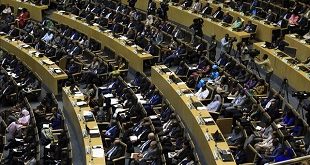
By Abdullahi Boru Halakhe
What are the reasons behind Al-Shabaab survival in Somali politics?
British Channel 4 journalist Jamal Osman had an exclusive on al-Shabab that included a training and graduation ceremony. The picture that emerged was that al-Shabab is a sophisticated group which, more than others, grasped the duality of the state; one of brutal efficiency in employing force and in the second order, the ability to undertake state’s benign “soft” function:
collecting garbage and ensuring pharmacies stock unexpired drugs.
In popular state formation theories what distinguishes or indeed makes a state a state, is its ability to project the use of force. By being the prominent purveyor of violence, the state increases the cost to anyone who wants to challenge it, and also provides an incentive for a group(s) to accept to be part of the state. Since its collapse, Somalia’s ability to function as a state and project the use of force has been outsourced to external actors. As a result – nature abhors a vacuum – al-Shabab or previously, warlords, filled in.
The group’s overarching understanding that the centre of gravity- for its survival- rests with the citizens, and not the state or external actors, explains their durability. As long as they can provide security – because they are the biggest source of violence anyway – and garbage is collected in areas that they control, it buys them legitimacy, albeit through fear.

While all external actors crave to be loved, al-Shabab thrives on fear. In understanding Somalis, one has to struggle with the paradox of being at once pastoral democrats – ready to negotiate some issues – and an unflinching republican, some relations like family are non-negotiable. Al-Shabab concentrated on the latter part. While Somalis can trenchantly disagree over their clan politics, however, when it comes to their sovereignty, both personal and collectively, they will never negotiate. They are unrepentant nationalists, and in the absence of a state, rhetorically and sometimes symbolically, al-Shabab acts as the vanguard and the only reliable guardian of Somali nationalism and identity.
This is further entrenched by the fact that the majority of the post-1991 governments have not been organically constituted – they have been externally midwifed, making al-Shabab a formidable custodian of the Somali identity.
While al-Shabab has that luxury, monopoly really, the Somali government has to juggle many contradicting and often competing interests – the Turks who would want to show Somalia as the testing ground for international Islamic brotherhood through a humanitarian lens, the Europeans and the Americans who have a mortal fear of the radicalisation of Somali youth immigrants, and the African Union that wants to prove the dictum African solutions to Africa’s problem.
Without any leverage, the Somali president/prime minister is left at the mercy of all these and many actors. All the while al-Shabab is capable of being run like a well-oiled machine. The Western countries have, by default, reduced their footprints and focus on counterterrorism. This is guided by rational calculations; limited footprint means limited domestic political consequences, inoculating themselves against accusation of invaders. But this singular focus on terrorism by the West is akin to attempting to address the symptoms rather than the cause of Somalia’s crisis – a classic Band-Aid solution.
African countries are enamoured by an African solution to Africa’s problems, but they suffer from naively thinking that since we are fellow Africans, Somalis will welcome us with flowers at the gates of Mogadishu. Just like any other modern intervention, the window between an intervention as liberation and invasion is small. In the case of the AMISOM, they need to grasp that reality urgently, otherwise, their genuine effort of winning over Afro-pessimists could be undone. In all, everyone is in Somalia for their own interests rather than the Somalis’, and that explains why al-Shabab succeeds where others fail.
Another group that most external actors could learn from is the khat distributors in Somalia. Since the collapse of the state in 1991, khat, also known as miraa – a mild stimulant popular in East Africa and grown in the Eastern part of Kenya – has been exported to Somalia during war and peace. It is distributed more efficiently than any food aid. This efficiency beats what any economist envisages when they speak about the virtues of the unseen hand of the market. This is despite al-Shabab banning khat as haraam – forbidden.
The group that has survived al-Shabab has an enduring lesson for all. Khat distribution networks and their resiliency is a case study on how to operate in a hostile environment. Maybe it is about time we undertake an unbiased study of al-Shabab and khat distributors on how to establish a state and an efficient distribution network of economic and public goods – the key prerequisites of a state.
Abdullahi Boru Halakhe is a security analyst on the Horn of Africa
 The Independent Uganda: You get the Truth we Pay the Price
The Independent Uganda: You get the Truth we Pay the Price


